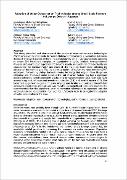Adoption of Water Conservation Technologies among Small Scale Farmers in Lwengo District – Uganda

View/
Date
2019Author
Nabalegwa, Muhamud Wambede
Asaba, Joyfred
Othieno, Esther Ebifa
Nabatta, Claire
Metadata
Show full item recordAbstract
This study identified and characterised the dominant water conservation technologies (WCT)
employed by small scale farmers in Malongo and Kyazanga sub-counties in Lwengo district.
It employed a cross sectional household survey design, using systematic sampling to obtain
380 household samples. A quantitative analysis, Multiple Correspondence Analysis (MCA)
and Logit regression model were used to analyse these data to identify and characterise the
dominant WCT and establish the most significant factor affecting the adoption of the
technologies. Results indicated that mulching was the most dominant WCT employed,
followed by Valley dams/reservoirs, terracing, tied ridges, deep tillage and infiltration pits. The
Logit model indicated that out of seven factors, five had a significant positive influence namely:
access to credit (1.3); farm slope location (0.7); farm size (0.4); access to agricultural inputs
and investment subsidies (0.4); and level of income (0.2). One factor had a significant negative
influence (engagement in other economic activities/off-farm employment activities) and only
one was found to be insignificant (access to market). It is recommended that the significant
water conservation techniques be upscaled, and that emphasis also be placed on the most
significant factors in order to strengthen the adoption of water conservation in the area.
